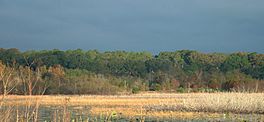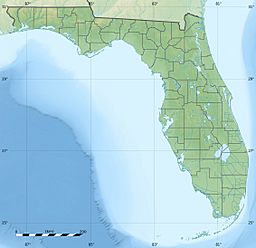Lake Jackson (Leon County, Florida) facts for kids
Quick facts for kids Lake Jackson |
|
|---|---|

Lake Jackson, September 2005, with storm approaching. Note flying ducks.
|
|

Map
|
|
| Location | Leon County, Florida |
| Coordinates | 30°31′46″N 84°19′21″W / 30.5294°N 84.3225°W |
| Type | prairie lake |
| Primary outflows | sinkholes |
| Catchment area | 42.1 square miles (109 km2) |
| Basin countries | United States |
| Max. length | 8 miles (13 km) |
| Surface area | 6.2 square miles (16 km2) |
| Surface elevation | max. 96.2 feet (29.3 m) |
Lake Jackson is a special lake located in Leon County, Florida, near the city of Tallahassee. It's known as a "prairie lake" and is not very deep. What makes it unique are two large holes in its bottom, called sinkholes. These are named Porter Sink and Lime Sink.
The lake is found in an area called the Red Hills Region. Its water level changes a lot. Sometimes, it can even dry up completely! Other times, it can be as high as 96 feet (29 m) above sea level. Lake Jackson is about 7.5 miles (12 km) long and covers an area of about 6.2 square miles (16 km2). No rivers or streams flow out of the lake.
Contents
Exploring Lake Jackson's Location
Lake Jackson is easy to find because Interstate 10 runs right along its southern edge. This highway helps people travel through the area.
Right next to the lake, you can find the Lake Jackson Mounds Archaeological State Park. This park is an important place where ancient people once lived.
Understanding Lake Jackson's Geology
Lake Jackson's geology is very interesting because of how it interacts with the ground beneath it.
What is Karst?
The area around Lake Jackson has a type of landscape called karst. Karst forms when soft rocks, like limestone, dissolve over time. Water seeps into cracks in the rock, making them bigger. This can create amazing underground caves and tunnels. Sometimes, the ground above these spaces can collapse, forming holes called sinkholes.
How Lake Jackson Drains
The water from Lake Jackson drains into a huge underground water supply called the Floridan aquifer. This happens through the sinkholes at the bottom of the lake. Usually, these sinkholes are partly blocked by mud and other materials.
However, when the level of the underground water drops, these blockages can collapse. This allows the lake water to rush down into the aquifer. When this happens, the lake can drain completely! This has happened many times throughout history. For example, newspaper records show the lake draining in 1829, and then again in 1840 and 1860. It also drained in 1907, 1909, 1918, 1932, 1936, 1956-1957, 1981-1982, and most recently in 1999.
Discovering Lake Jackson's Wildlife
Lake Jackson is a busy home for many different animals and plants. It's a great place to observe nature.
Amazing Animals of Lake Jackson

Many kinds of birds that live near water can be found at Lake Jackson. These include the tall great blue heron and the smaller little blue heron. You might also spot the elegant great egret and the snowy egret. Other birds include the limpkin, Moorhen, American coot, and the large wood stork.
Birds of prey like the osprey and the majestic bald eagle also hunt here. You might hear the calls of a fish crow or see a tiny least tern. Even Brown pelicans, which usually stay near the ocean, have been seen here sometimes!
Reptiles and amphibians are common too. Look out for the American alligator, Southern chorus frog, Southern leopard frog, and the Florida softshell turtle. Among the mammals living near the shore is the round-tailed muskrat.
Cool Plants of Lake Jackson

The lake is full of plants that grow underwater. These include blue hyssop, coontail, green fanwort, variable-leaf milfoil, and bladderwort.
Near the edges of the lake, you'll find marsh plants. These include maidencane, pickerelweed, the beautiful American lotus, and slender spikerush.
Even drier parts of the marsh have many trees and woody plants. You can see sweetgum trees, different kinds of oaks, wax myrtle, the Carolina willow (salix caroliniana), and elderberry. Unfortunately, some plants that don't belong here, like Chinese tallow and hydrilla, have also started to grow in some areas.
Protecting Lake Jackson
Lake Jackson is a very important natural area. Because of this, it is part of the Lake Jackson Aquatic Preserve. This preserve also includes Lake Carr and Mallard Pond. The preserve was created in 1973 to help protect these special water bodies and the wildlife that depend on them.



